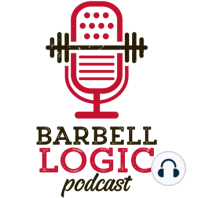39 min listen
Verbal Communication (Let's Talk) - #412
FromBarbell Logic
ratings:
Length:
40 minutes
Released:
Jun 14, 2022
Format:
Podcast episode
Description
Today, Matt & Niki delve into verbal communication - our primary means of communication as a coach, both in-person & online. While this may seem straightforward, many steps occur to correctly communicate to our clients & get them to move correctly. This begins & 3-part series of sorts where Matt & Niki will explore communication, beginning with verbal & touching on tactile & visual (and the differences between in-person and online). No video this week for YouTube viewers. We tried a new recording platform & lost the video. Bear with us while we try to improve our logistical & technological systems. Thanks! Verbal Communication on the Platform What has to occur for effective communication to occur on the platform? The coach must first see the lift, process that information, and compare what he sees to the model in his head (which may be imperfect). Following this, he must understand any deviations from the model, prioritize them, understand how to correct them, and deliver information to the lifter in the form of a cue (e.g. "knees out"). That's a lot. But communication involves two people and is a two-way street. Hearing the cue, the lifter must then understand it (each word and the words together). The lifter takes that information and use it to attempt to change her movement in light of that new information. Then the lifter moves. The coach returns to the picture, and the process is repeated. Did the lifter fix the error (and potentially additional errors)? Was there an overcorrection? Did nothing change at all? Don't worry, though, while much is involved, we can simplify this process and accelerate your effectiveness as a coach. Teaching Versus Cueing Typically, a coach takes in information regarding new lifters, to understand those lifters' backgrounds. This helps the coach determine his approach with their first interaction. Coaches may perform a teaching progression, which both gets the lifter moving correctly while including certain words & phrases that will likely inform cues that the coach may use during the lifter's sets. It can be a good idea to walk lifters through the teaching progression, especially if you're a newer coach. For online coaching, teaching may involve some how to videos demonstrating proper form. Articles and podcasts that address lifting basics may begin to deepen the lifter's understanding. Understand that in order for a cue to be effective, it must be understood. Teaching should first focus on the "how"s. Teaching enables better understanding of cueing and coaching during the sets. As teaching progresses - as the lifter & coaching relationship lengthens and deepens - the focus of teaching moves from the "how"s to the "why"s, and this is often why good coaches are born as clients, because as they improve as lifters and learn the "why"s from a good coach, they consider coaching themselves. Practical & Effective Verbal Cues Let's move past the theoretical and come to the practical. What should you do on the platform? Some basic principles of good cueing can help steer you in the right direction. Cues should be: Brief - keep cues short *Confident - don't portray doubt *Loud - cues must be heard Clear - avoid big words Positive when appropriate - a "good" communicates that the lifter is correctly performing the movement *Note: loud & confident does not mean yelling (necessarily) - deliver appropriate cue for environment & lifter Cues must be understood, and more words means more words that can misunderstood or not heard. Keep cues short and use short words. If you're a new coach and not 100% sure about the cue, act like you are. Don't deliver a cue with doubt or like it's a question. Give the cue and evaluate and re-evaluate based on the lifter's movement. Lastly, seminars and powerlifting meets can skew cue volume. Cues must be heard, but they don't have to be yelled. Furthermore, increasing the volume tends to increase the confusion. If you deliver a cue, nothing changes, and deliver it again m
Released:
Jun 14, 2022
Format:
Podcast episode
Titles in the series (100)
#211 - The Perfect Problem: Learning to Be Kind To Yourself When You Fail: Barbell Logic has long attracted thinkers, strivers, and a fair number of Type A personalities. "Logic" is in the name, of course, and barbell training in particular demands a sort of consistency and attention to detail that is well-suited to the... by Barbell Logic
